
The Superintendent of School District 73 says he would only close Sa-Hali Secondary School on the advice of Interior Health.
Its after there have been 16 cases of COVID-19 at the school after five exposure events in a two week span in January.
“I have no such advice to do that,” Terry Sullivan said. “I can close the school if there’s a water break of if they don’t have have power – those types of things. No dispute about that. But I can’t close the school for health reasons. They would have to do that, and they would have to direct me and advice me to close it. I’ve read the Act.”
“My understanding from health is that they’ve only directed one school in the province be closed. As I remember from the news media, part of it was operations that they did not have enough staff to maybe be able to operate the school. This particular situation doesn’t meet that threshold at all.”
There are now 13 cases among students, and still three cases are among staff at Sa-Hali Secondary. Another approximately 225 students and 18 staff are self-isolating according to Sullivan after coming in close contact with people who tested positive.
Sullivan notes Sa-Hali Secondary is able to stay open with teacher’s on-call because of a significant drop in the number of students coming to school these days. At the last update there were only about 20 to 25 per cent of the 900 students coming to school because of the exposures.
Asked whether the school would be ordered to close given the concerns from parents and staff, the Chief Medical Health Officer for Interior Health noted that is a decision for the Kamloops-Thompson School District to make.
“We look at the cases and if we identify a case, we look at the contacts and then we ask the contacts to stay home until their 14 day period is up. So if it becomes more of an operational issue, then they may make that decision usually,” said Dr. Albert de Villiers.
“We will not ask them to close down. We’ll just ask them to keep on [following their] plan and they run the school as they want. I know some schools have chosen to go partly online and partly in-person classes, and that depends on them completely. We don’t really give them guidance on that.”
He also noted that with most of the cases at Sa-Hali Secondary have been coming from the community, a point also echoed by Sullivan, who says SD73 is in regular contact with Interior Health.
“There might be very limited spread within the student population within the school but the schools do have really good COVID plans in place,” de Villiers said, noting that in instances where there has been an increase in cases in a school, a public health inspector will be in contact with school officials.
“They go in and if they see the school doesn’t follow COVID plans at all, that if they’ve got nothing in place, that if students are actually at risk, and if there’s uncontrolled spread proven within the school, at that point we can considered [closing the school]. But like I said, I can’t see that happening at this point, and their plans are really really good.”
“If the plan meets their criteria, we will not ask them to close down. We will just ask them to keep on doing the plan,” de Villiers added.
Added Sullivan, “they’ve looked through the plans, and they said ‘no, there’s no reason to close. You’re following all of the directions we’ve given.'”















